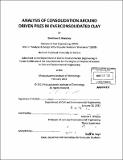| dc.contributor.advisor | Andrew J. Whittle. | en_US |
| dc.contributor.author | Niarchos, Dimitrios G | en_US |
| dc.contributor.other | Massachusetts Institute of Technology. Dept. of Civil and Environmental Engineering. | en_US |
| dc.date.accessioned | 2012-05-15T21:10:34Z | |
| dc.date.available | 2012-05-15T21:10:34Z | |
| dc.date.copyright | 2012 | en_US |
| dc.date.issued | 2012 | en_US |
| dc.identifier.uri | http://hdl.handle.net/1721.1/70764 | |
| dc.description | Thesis (S.M.)--Massachusetts Institute of Technology, Dept. of Civil and Environmental Engineering, 2012. | en_US |
| dc.description | Cataloged from PDF version of thesis. | en_US |
| dc.description | Includes bibliographical references (p. 161-169). | en_US |
| dc.description.abstract | The principal objective of this thesis is to assess the capabilities of an already established analytical framework for understanding and predicting the behavior of piles driven in highly overconsolidated clays (OCR24). The skin friction mobilized during pile loading to failure depends on the sequence of preceding events, i.e. pile installation and soil consolidation. This research utilizes the Strain Path Method (SPM) to simulate the disturbance caused by pile installation with a general effective stress soil model, MIT-Si, which is capable of modeling adequately the anisotropic stress-strain response of clays at large OCR. Following the pile installation, one-dimensional, non-linear, coupled consolidation analyses around the pile shaft are performed using the finite element code ABAQUS, simulating the earth and pore pressure equalization. The MIT-Si model has been integrated within the ABAQUS code. The MIT-SI model provides predictions of installation stresses that are generally consistent with prior work by using the MIT-E3 model. However, the research encountered several numerical problems during consolidation. Although some of these numerical issues have not been resolved, they do not appear to affect the current predictions of stresses at the pile shaft. The main contribution of this research is the extension of the capability offered by the aforementioned analytical framework to cover highly overconsolidated clays (OCR24). In general, the results show that the zone of disturbance in in terms of excess pore pressures around the pile generated by the MIT-SI model is much larger compared to MIT-E3 predictions. This discrepancy leads to different predictions between the two soil models particularly close to the pile shaft at the end of consolidation. | en_US |
| dc.description.statementofresponsibility | by Dimitrios G. Niarchos. | en_US |
| dc.format.extent | 184 p. | en_US |
| dc.language.iso | eng | en_US |
| dc.publisher | Massachusetts Institute of Technology | en_US |
| dc.rights | M.I.T. theses are protected by
copyright. They may be viewed from this source for any purpose, but
reproduction or distribution in any format is prohibited without written
permission. See provided URL for inquiries about permission. | en_US |
| dc.rights.uri | http://dspace.mit.edu/handle/1721.1/7582 | en_US |
| dc.subject | Civil and Environmental Engineering. | en_US |
| dc.title | Analysis of consolidation around driven piles in overconsolidated clay | en_US |
| dc.type | Thesis | en_US |
| dc.description.degree | S.M. | en_US |
| dc.contributor.department | Massachusetts Institute of Technology. Department of Civil and Environmental Engineering | |
| dc.identifier.oclc | 789667047 | en_US |
